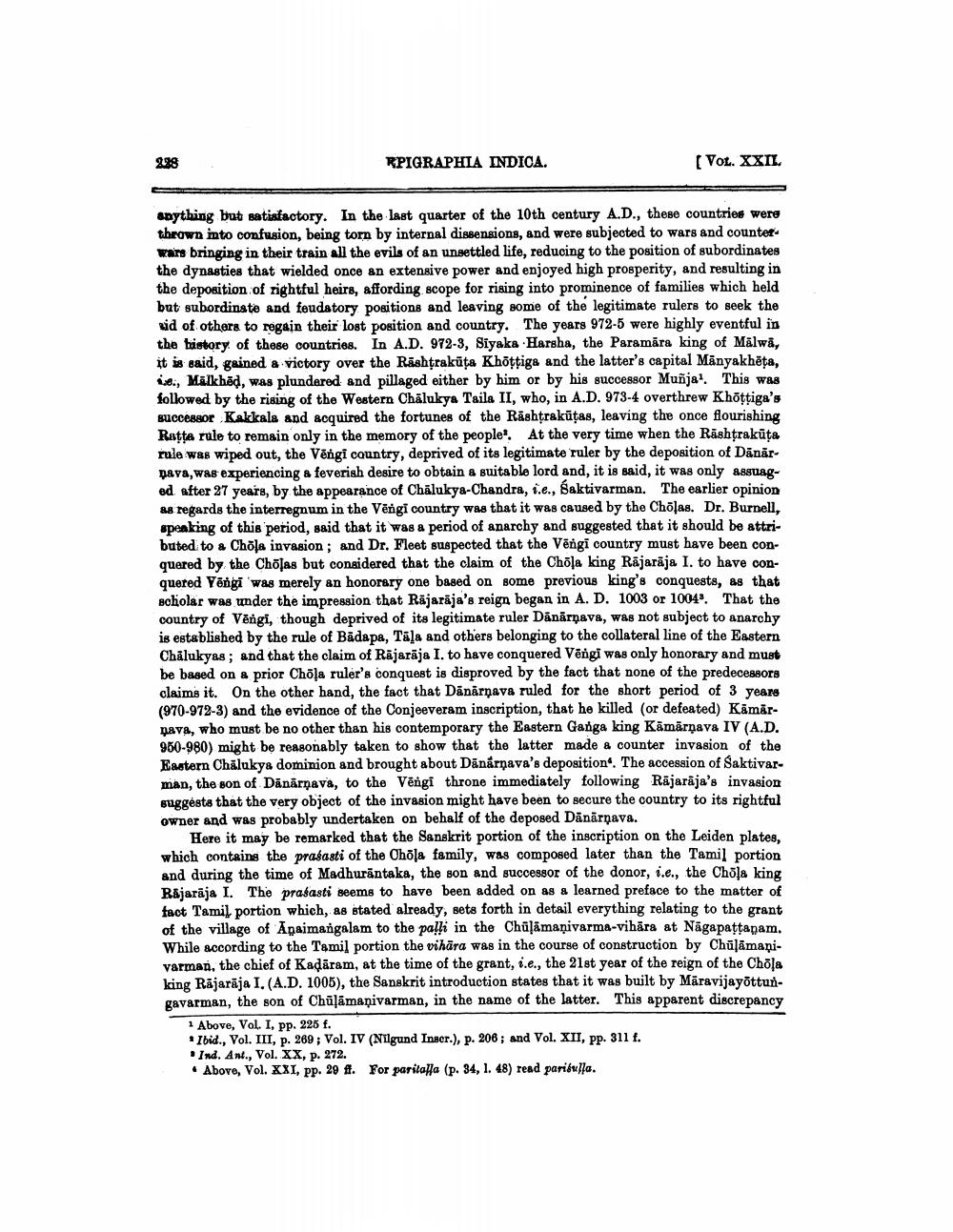________________
2.28
RPIGRAPHIA INDICA.
[VOL. XXIL
anything but satisfactory. In the last quarter of the 10th century A.D., these countries were thrown into confusion, being torn by internal dissensions, and were subjected to wars and counter wars bringing in their train all the evils of an unsettled life, reducing to the position of subordinates the dynasties that wielded once an extensive power and enjoyed high prosperity, and resulting in the deposition of rightful heirs, affording scope for rising into prominence of families which held but subordinate and feudatory positions and leaving some of the legitimate rulers to seek the aid of others to regain their lost position and country. The years 972-5 were highly eventful in the history of these countries. In A.D. 972-3, Siyaka Harsha, the Paramāra king of Malwa, it is said, gained a victory over the Rashtrakuta Khōṭṭiga and the latter's capital Manyakheta, ie., Malkhed, was plundered and pillaged either by him or by his successor Muñja1. This was followed by the rising of the Western Chalukya Taila II, who, in A.D. 973-4 overthrew Khōṭṭiga's successor Kakkala and acquired the fortunes of the Rashtrakutas, leaving the once flourishing Ratta rule to remain only in the memory of the people. At the very time when the Rashtrakuta rule was wiped out, the Vengi country, deprived of its legitimate ruler by the deposition of Danarpava, was experiencing a feverish desire to obtain a suitable lord and, it is said, it was only assuaged after 27 years, by the appearance of Chalukya-Chandra, i.e., Saktivarman. The earlier opinion as regards the interregnum in the Vengi country was that it was caused by the Chōlas. Dr. Burnell, speaking of this period, said that it was a period of anarchy and suggested that it should be attributed to a Chōla invasion; and Dr. Fleet suspected that the Vengi country must have been conquered by the Cholas but considered that the claim of the Chōla king Rajaraja I. to have conquered Yengi was merely an honorary one based on some previous king's conquests, as that scholar was under the impression that Rajaraja's reign began in A. D. 1003 or 1004. That the country of Vengi, though deprived of its legitimate ruler Dānārņava, was not subject to anarchy is established by the rule of Badapa, Tala and others belonging to the collateral line of the Eastern Chalukyas; and that the claim of Rajaraja I. to have conquered Vengi was only honorary and must be based on a prior Chōla ruler's conquest is disproved by the fact that none of the predecessors claims it. On the other hand, the fact that Danarnava ruled for the short period of 3 years (970-972-3) and the evidence of the Conjeeveram inscription, that he killed (or defeated) Kämärnava, who must be no other than his contemporary the Eastern Ganga king Kämärṇava IV (A.D. 950-980) might be reasonably taken to show that the latter made a counter invasion of the Eastern Chalukya dominion and brought about Dänarnava's deposition. The accession of Saktivarman, the son of Dänarnava, to the Vengi throne immediately following Rajaraja's invasion suggests that the very object of the invasion might have been to secure the country to its rightful owner and was probably undertaken on behalf of the deposed Dänārņava.
Here it may be remarked that the Sanskrit portion of the inscription on the Leiden plates, which contains the prasasti of the Chōla family, was composed later than the Tamil portion and during the time of Madhurantaka, the son and successor of the donor, i.e., the Chōla king Rajaraja I. The prasasti seems to have been added on as a learned preface to the matter of fact Tamil portion which, as stated already, sets forth in detail everything relating to the grant of the village of Apaimangalam to the palli in the Chūlāmaṇivarma-vihara at Nagapaṭṭanam. While according to the Tamil portion the vihara was in the course of construction by Chulāmaņivarman, the chief of Kaḍāram, at the time of the grant, i.e., the 21st year of the reign of the Chōla king Rajaraja I. (A.D. 1005), the Sanskrit introduction states that it was built by Maravijayōttungavarman, the son of Chūlāmaņivarman, in the name of the latter. This apparent discrepancy
1 Above, Vol. I, pp. 225 f.
Ibid., Vol. III, p. 269; Vol. IV (Nilgund Inser.), p. 206; and Vol. XII, pp. 311 f.
Ind. Ant., Vol. XX, p. 272.
Above, Vol. XXI, pp. 29 ff. For paritalla (p. 34, 1. 48) read parisulla.




